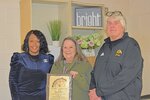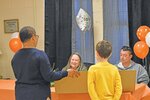


Daphne Wood led the evolution of technology in Blackville-Hilda schools during her 37-year career as technology director.
Wood arrived at her surprise retirement luncheon on March 16 with a report in hand. While she was prepared to work until the last minute, fellow administrators, educators, and family were eagerly waiting to surprise her.
“On behalf of Barnwell 19’s district, you were instrumental in getting all the technology that we have,” said David Corder, current director of operations and upcoming superintendent at the Barnwell County Consolidated School District (BCCSD). “You’re an unsung hero.”
Wood first came to the former Blackville-Hilda District 19 (D19), now BCCSD, in 1987.
“When I first came in ‘87, technology was Word processing and that was in the high school labs,” said Wood of the few computers available at the school. “Most of them were used to remediate math or English.”
“At Blackville-Hilda High School, there were only a half dozen computers in 1987,” said Corder.
The internet was ‘born’ just four years earlier in 1983 and slowly spreading into rural areas such as Blackville. Wood was an integral part in bringing this new technology to the district and helping the community adapt to something they have never seen before.
Wood’s first tech-based project was called Writing to Read which was implemented through IBM, an international technology corporation.
Writing to Read was piloted with pre-K and first grade students.
“The program was developed under the notion that students came to school with a limited vocabulary,” said Wood. “They can talk and say what they want. This particular lab set up said, ‘if you could speak it, you could write it phonetically.’ So it encouraged students.”
Although students were feeling successful, teachers were not yet sold. Students were writing words with incorrect spelling, but understanding the meaning.
“I had some teachers who were not willing or ready to get into technology. It was a brand-new frontier for all of us,” said Wood. “We had to break barriers through administrators and teachers to get to those students.”
Wood saw students involved in this program increase their learning and conversely saw a decrease in students who were not.
In addition to this program, which eventually fizzled out, Wood was in charge of keyboarding classes in all three schools in the district.
While in her first year, Wood was being sent to conferences by former D19 superintendent Richard Huggins who she described as a “very forward looking superintendent.”
“When he let me go to that conference, it hooked me for life,” said Wood.
She watched the growing world of technology open before her eyes at these conferences and realized this is where she was meant to be.
Wood first moved to Blackville from Tennessee in 1984 after graduating from the University of Tennessee with a degree in design.
While at home raising her son, Huggins stopped and knocked on her door one day offering her a job starting the Writing to Read program. Knowing little about computers or technology at the time, she accepted the challenge.
After attending her first conference, she learned about grants to bring these new innovations to Blackville. Huggins encouraged her to go after it.
“That is the other beauty of working in my district, I had some wonderful teachers and other administrative staff that saw my excitement and bought into it,” said Wood.
Another one of these educators was Harriet Pritchard. Wood was stepping into uncharted territory with grant writing and Pritchard would aid her with perfecting the grammar.
“She helped me so many times writing grants and cleaning them up for me,” said Wood. “And then we started raking in the money to get things!”
Another educator and friend essential in Wood’s tenure at D19 was Rosanne Montjoy.
“Throughout the years, you’ve been more than a coworker to me. We’ve been through a lot together,” said Montjoy.
The pair would often make trips to Columbia to deliver the grants Wood wrote.
Each year Wood would apply for multiple grants to keep technology growing in the district. She was responsible for updating the grant agency and reporting on the implementation. This was a constant task as technology was rapidly changing.
The next step was getting teachers on board with shifting their style in the classroom to one more technology based. Luckily, Wood felt continually supported.
“She did drag us, kicking and screaming, into the 21st century,” said Corder.
“I knew if I had them on my side it would be easier to do,” said Wood of teachers adapting to technology.
“Some teachers just came in so ready…This was even before the colleges were getting teachers ready for technology,” said Wood. “We really were pioneers in implementing this.”
In the late 80s, rural areas did not always have the groundwork laid to implement new and upcoming technology.
However, Wood made sure Blackville was kept in the forefront. She served on state committees implementing technology across the state where she “had opportunities there to represent our rural community,” said Wood.
“For some people it could have been boring, but I thrived on it,” she said. This was fueled both by her love for technology and her students.
At the time, telephone companies would provide two sets of cabling with a patch panel to then be hooked to the schools allowing for network access.
Due to her connections and other schools not being prepared, Wood was able to get more patch panels. On a day she called ‘net day,’ the community showed out to help her bring this to the students.
“We got enough to pull five cables to every single classroom in our district, and the media center,” said Wood. “I had three men that worked some way or another with cabling and I put them head of each school to direct.”
60 volunteers came out to help. They started with the far end rooms and worked their way through the school.
Then came time to terminate the cables– the connection of a wire to equipment, panels, or a wall outlet, which allows for connecting the cable to other cables or devices. She recruited two students from the Barnwell County Career Center looking for summer credit, and helped them terminate cables all summer.
“I guess we were primitive, but we did good and we were able to start our networking and get our computers in there to be networked,” said Wood.
Once this was established, things advanced again.
“The next thing that came along was the internet,” said Wood, who felt things were growing beyond her knowledge.
“When I was at one of the conferences years ago, they were telling us no one could actually forecast all the changes that were coming up,” said Wood. “We were trying to envision what that was going to look like.”
Wood was beginning to see what they spoke about years ago– students no longer needing textbooks and everything becoming digital.
“It is just fascinating to see where we are now, and even how this can grow and change. What unique concept does somebody have out there working on that will just change life forever?” said Wood.
Wood couldn't help but “fall in love with this stuff.” She found world-changing technologies on the cusp of creation to be captivating. Much of her passion was driven by the students.
“They deserve more. They deserve whatever we can get them,” said Wood. “These young people need to be ready when they get to school and I don't want them being hindered by not having opportunities that we failed to give them.”
During much of this process, funding was still scarce which prompted Wood to write more grants and coordinate contracting to get internet to the district.
Wood never saw her district as one that was undeserving of these advancements because it is rural and she worked tirelessly for over 37 years to bring everything she could to the students.
“If it wasn’t for the students we wouldn't be here,” said Wood. “I always kept that in mind with everything I did.”
One funding source that was constantly helpful was E-Rate– a federal, universal service support program helping schools and libraries get broadband access. Residents are charged a few cents on their phone bill to support this endeavor.
“This brought us our infrastructure and helped maintain it,” said Wood.
She finally hit a point where the groundwork was laid and she was maintaining what had been implemented. Then more change came her way.
“What tore the flood gates open was COVID,” said Wood.
She was able to get internet capabilities to the district, but could not guarantee internet access to each student’s home. At the time, e-learning was already being considered at both local and state levels. However, the pandemic left little time for much consideration.
After the COVID pandemic escalated in March 2020, Wood spent the following summer months getting students equipped to learn from home.
“By August we were up and running with e-learning,” said Wood. “We had already started buying Chromebooks and another pot of money came through to get us hotspots for our students who did not have access to the internet at home.”
The only areas where access was limited were the gray areas of the county without broadband services.
Wood also encouraged the district to get a laptop for middle and high school students to take home as well as one to keep at their school. She found this cut down on the damage while in transportation and avoided their laptop being left at home.
Once Wood got a handle on e-learning amidst a global pandemic and it was running smoothly, the consolidation of D19 and Williston-Elko District 29 began in 2022.
She was now tasked with merging all technological components of each district.
“We can never repay you for the countless hours you poured into consolidating two fine school districts,” said former BCCSD superintendent Dr. Marcella Shaw. “We were able to successfully consolidate, and you were a huge part of that Daphne.”
Wood has left a legacy at D19. When computers click on and connect to the district network seamlessly, that was the doing of her. When students needed to catch up on work from home, she led the force to make it possible.
“It took a team to get everything done over all these years. Yes I had obstacles, but I had people who would help me break those barriers. I thank you all for it. I have enjoyed working with each and everyone of you. It doesn't matter if it was during school or after school,” said Wood.
“This is never goodbye. This is always home, and these doors swing on welcome hinges. You are free to come back at any point in time,” said Dr. Shaw.
Wood is looking forward to spending her retirement with her family and friends.